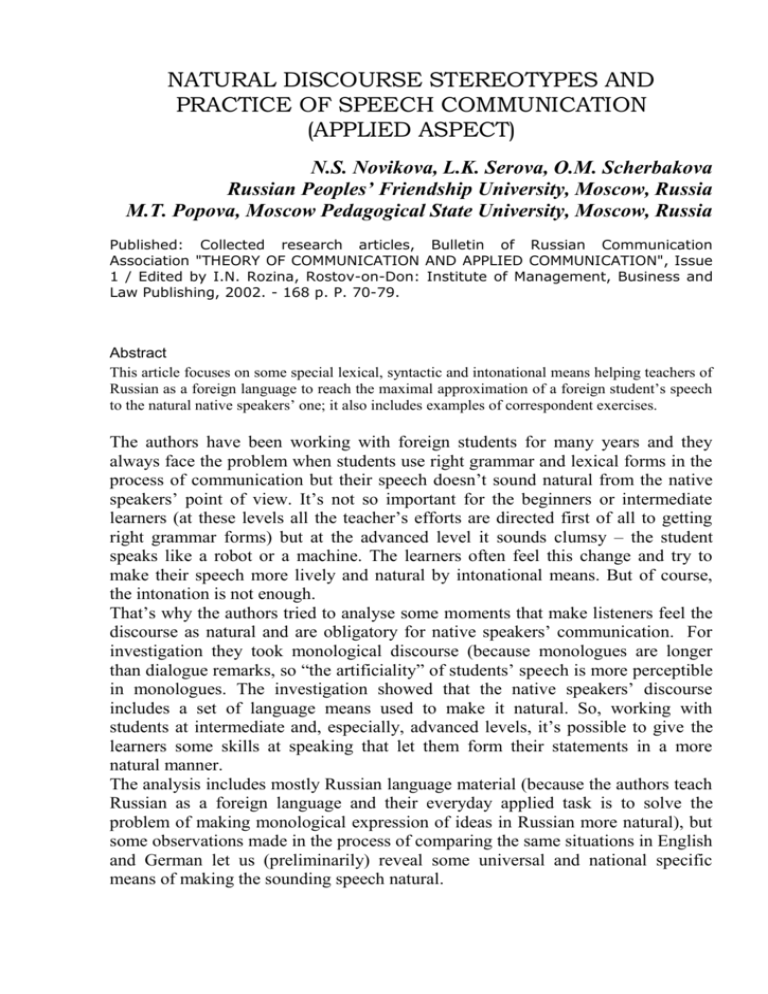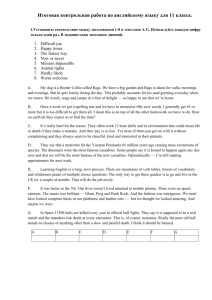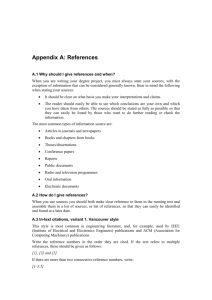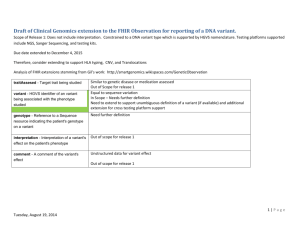natural discourse stereotypes and practice of speech communication
advertisement

NATURAL DISCOURSE STEREOTYPES AND PRACTICE OF SPEECH COMMUNICATION (APPLIED ASPECT) N.S. Novikova, L.K. Serova, O.M. Scherbakova Russian Peoples’ Friendship University, Moscow, Russia M.T. Popova, Moscow Pedagogical State University, Moscow, Russia Published: Collected research articles, Bulletin of Russian Communication Association "THEORY OF COMMUNICATION AND APPLIED COMMUNICATION", Issue 1 / Edited by I.N. Rozina, Rostov-on-Don: Institute of Management, Business and Law Publishing, 2002. - 168 p. P. 70-79. Abstract This article focuses on some special lexical, syntactic and intonational means helping teachers of Russian as a foreign language to reach the maximal approximation of a foreign student’s speech to the natural native speakers’ one; it also includes examples of correspondent exercises. The authors have been working with foreign students for many years and they always face the problem when students use right grammar and lexical forms in the process of communication but their speech doesn’t sound natural from the native speakers’ point of view. It’s not so important for the beginners or intermediate learners (at these levels all the teacher’s efforts are directed first of all to getting right grammar forms) but at the advanced level it sounds clumsy – the student speaks like a robot or a machine. The learners often feel this change and try to make their speech more lively and natural by intonational means. But of course, the intonation is not enough. That’s why the authors tried to analyse some moments that make listeners feel the discourse as natural and are obligatory for native speakers’ communication. For investigation they took monological discourse (because monologues are longer than dialogue remarks, so “the artificiality” of students’ speech is more perceptible in monologues. The investigation showed that the native speakers’ discourse includes a set of language means used to make it natural. So, working with students at intermediate and, especially, advanced levels, it’s possible to give the learners some skills at speaking that let them form their statements in a more natural manner. The analysis includes mostly Russian language material (because the authors teach Russian as a foreign language and their everyday applied task is to solve the problem of making monological expression of ideas in Russian more natural), but some observations made in the process of comparing the same situations in English and German let us (preliminarily) reveal some universal and national specific means of making the sounding speech natural. Thus, as we have already said, there’s a whole set of means to make oral speech more natural which can be divided into three big groups: 1) lexical, 2) syntactical, 3) intonational. Let’s give a brief characteristic of each of the mentioned groups. Lexical means used for making oral speech more natural include the following: Variant 1 Человек пришёл на рынок купить попугая. Там человек увидел красивого попугая. Variant 2 Один человек пришёл на рынок купить попугая. Там этот человек увидел красивого попугая. 1) Use of the word один (-а, -о, -и) (by analogy to the English indefinite article a) at the beginning of narration and further use of the demonstrative pronoun этот (а, -о, -и) (by analogy to the English definite article the). Let’s compare two variants of the beginning of a story – Variant 1 (given by a student) and Variant 2 (partially corrected by the teacher). Variant 1 Человек пришёл на рынок купить попугая. Там человек увидел красивого попугая. Variant 2 Один человек пришёл на рынок купить попугая. Там этот человек увидел красивого попугая. Variant 2 sounds obviously more coherent and a bit more natural (though it’s far from the natural speech of a native speaker, of course). 2) Use of the words раз, как-то, как-то раз or the word однажды in the initial phrase (the last form is a bit more formal than the first two ones – so it’s preferable to use как-то, как-то раз, раз in the colloquial speech). Compare three variants of the first phrase of the story: Variant 1 Человек пришёл на рынок купить попугая. Variant 2 Один человек пришёл на рынок купить попугая. Variant 3 Как-то раз один человек пришёл на рынок купить попугая. The example obviously shows that the speech becomes more natural when we introduce additional lexical units. Thus, Variant 1 has no elements that could provide gradualness of introduction to the described situation. Variant 3 has two elements of this kind – the word combination как-то раз and the word один. The absence of such “introductory” elements sounds clumsy to native speakers – some language redundancy prepares (“tunes”) the listener for the following narration and represents a kind of theme, followed smoothly by the rheme (the topic). It’s interesting to know that the presence of introductory elements (which are redundant) is characteristic of oral beginning of narration in English. Compare four variants of the beginning of a story: Variant 1 A man was sitting in his office… Variant 2 This man was sitting in his office… Variant 3 There was a man, sitting in his office… Variant 4 There was this man, sitting in his office… Variant 1 is a literary standard, Variants 2, 3, 4 show an increasing degree of colloquial style as the indefinite article a changes into the demonstrative pronoun this and then into the redundant construction there was that represents a “quasitheme” and gives an introduction to the situation. Note that Variants 2 and 4 use the demonstrative pronoun this instead of the standard article a, it breaks the traditional standard and determines that the beginning belongs to the style of anecdote or oral story, it creates a confidential atmosphere and prepare the listener: “we understand which man we are going to speak about and this common knowledge unites us”. Note that at the beginning of a dialogue in any language we almost always use such preparing or “tuning” means creating contact. We begin with the words listen, excuse me, please, tell me etc., because an absence of such constructions (imitating the theme) and beginning with the topic (the rheme) is understood by the listener as a breach and sometimes a lack of respect to him. We can remark that using this form of the monologue beginning we involve the listener in an implicit dialogue (cf. monologues pronounced on the stage by comedians and lectures or reports given by good public speakers – it’s an implicit inclusion of listeners in the monologue that creates an effect of a contact with the audience and increases the clarity of the report). 3) To maintain the contact with the listener (to keep the listener in the implicit dialogue) during the entire monologue the speaker uses lexical means maintaining contact. First of all, they are different discourse markers (parenthesis words and expressions) and constructions that show the speaker’s attitude to the content of the pronounced monologue (confidence/a lack of confidence in the reality of the story, reference to the source of information, demonstration of feelings evoked by the statement etc.). We know from experience that natural discourse is full of such elements and an abundance of discourse markers is characteristic not only of natural oral speech but also of other styles, i.e. scientific style. There is difference in a choice of concrete words and expressions from all the variety of such forms: thus, in oral speech we meet contact-maintaining lexical means such as представляешь, знаешь, понимаешь (imagine, you know, you see), Russian constructions with the particle ли (видишь ли, знаешь ли) and even redundant “parasitic” words ну, в общем that can’t be used in a scientific article, for example. By analogy to Russian “parasitic” words, an English speaker uses such redundant elements as you know, well etc. 4) Ending his monologue, the speaker gives a signal to the listener that the story is over: such words and combinations as вот, вот и всё, вот так вот are often used as signals. Thus, speaking about lexical means making our speech natural, we can draw a conclusion: use of redundant elements is a universal means of natural discourse that is characteristic of many languages. The redundant elements divide into establishing contact, maintaining contact and ending contact. The Russian language uses inversion in word order as syntactic means to make our speech natural; for example, the verb can go in initial position in a sentence. Such position is very effective to make a monologue sound natural. Remember the usual beginning of anecdotes: Вернулся муж домой из командировки и… Пришёл Василий Иванович к Петьке и… Купил один мужик собаку и… Try to put the verb in its normal position and you’ll see that the anecdote will lose all its “salt” or at least a part of comical effect on the listener (and this is the foreign students’ manner of telling anecdotes in Russian). In the same manner we often begin telling fairy tales – because we need a contact with our little listeners, as close as possible. So we’ll start the tale about Little Red Riding Hood like that: «Пошла Красная Шапочка к бабушке... Пришла она к бабушке и увидела Волка». The same method is widely used by comic writers. For example, we all know comic monologues by Victor Koklushkin. Remember some beginnings of them: «Подходит ко мне на улице один, говорит: «Хотите заработать?» (short story «Гербалайф»). «Ну, пошли мы к этому мужику…» (short story «Конец цитаты»). «Работал я тогда в бане инженером…» (short story «На всех парах»). There are many similar examples in the stories by other comic writhers. Let’s also compare two variants of the beginning of the story mentioned above: Variant 1 Как-то один человек пришёл на рынок купить попугая. Там он увидел красивого попугая… Variant 2 Пришёл как-то один человек на рынок купить попугая. Увидел он там красивого попугая… Variant 2 seems to be the most natural and convenient beginning for a story confidentially told in an informal situation. We can say that initial verb position 1) determines the following story style – a narration; 2) introduces the listener to the situation and marks the presupposition of the following story, determines the theme and intensifies the effect of non-completion, gives a signal that the narration will continue and the rheme is ahead. It’s interesting to know that the same regularity is used in German – breaking the usual word order by putting the predicate in the initial position to create a confidential atmosphere with the listener and to intensify the following comical effect. Thus, telling an anecdote or a true story, a native speaker of German will also put the predicate in initial position (though the German grammar is known to be very regular and needs the predicate at the end of the phrase). For example, Sitzen drei alte Frauen zusammen auf einer Bank,… (Сидят три старушки на скамейке…). Kommt ein Mann zum Arzt und sagt: “Ach, Herr Doctor,… (Приходит один мужчина к врачу и говорит: «Ах, господин доктор…»). Steht ein Liebespaar am Meeresufer und beobachtet den Sonnenuntergang,… (Стоит влюблённая пара на берегу и смотрит, как садится солнце…). Usual literary rule (normative word order) is partially broken in all the given examples and this makes the beginning natural and establishes a contact with the audience. We should say that if a German speaker wants to make his speech natural, he changes word order and also uses only the Present tense of verbs (even speaking about the past). The same rule is characteristic of the English language. Note that in Russian it’s preferable to use the Present Tense in such situations (though this is not obligatory). And what is more, if we teach students that in normal literary speech when using several verbs as the same part of the sentence we should put them in the same form, in a natural monologue mixed use is possible and sometimes preferable to make it more expressive, compare: Neutral style Он увидел попугая и спросил… Он пришёл домой и сказал… Expressive narration Увидел он попугая и спрашивает… Пришёл он домой и говорит… So if we want to make our speech more expressive and natural, we use the Present Tense of such verbs as спрашивать, отвечать, говорить, объяснять (ask, answer, speak, explain) even if we speak about the past where the other verbs are in the Past Tense. If we have to make the narration maximally natural, the pattern of the initial monologue phrase can be the following: a) if the story we’re speaking about happened only once in the past and the initial moment is not definite: Verb + Subject + Как-то Как-то раз Однажды + The rest of the sentence The verb can be used in the Past Perfective or Present Imperfective form. Compare: Приехал он как-то раз в Москву… Приезжает он как-то раз в Москву… b) if the story we’re speaking about happened only once in a definite moment of time (yesterday, the day before yesterday, last week, last time etc.): Verb + Subject + Вчера, позавчера, сегодня, утром, + час назад, прошлый раз и т. п. The rest of the sentence In such constructions the verb can be used in the Past Perfective or (preferably) in the Present Imperfective form. Compare: Приехал он вчера в Москву… Приезжает он вчера в Москву… c) if the story happened many times: Verb + Subject + Бывало + The rest of the sentence The verb can be used in the Past Imperfective, the Present Imperfective or the Future Perfective form. Compare: Приезжает он, бывало, в Москву… Приезжал он, бывало, в Москву… Приедет он, бывало, в Москву… This beginning narration structure can be easily explained from the point of view of modern stylistics. As G.Y. Solganik says, “the beginning is a key phrase, a kind of subject, a theme. … the beginnings of the fragments form semantic and syntactic frame of the text, serve as the main means of its organization, they are the moving force of the plot and development of the idea … The whole complex of the beginnings is just a brief content, a summary of the text” ((1), с. 67-68). In the given examples the beginning with the predicate in initial position gives the maximal information about the following story: 1) determines the reference to functional and genre style (colloquial speech, anecdotes); 2) involves the listener in the implicit dialogue from the very beginning, prepares him for the following story. It’s interesting to know that in literary texts (where the authors wanted to make the narration natural, existing in the real speech) the beginnings of the initial phrase and fragments also start with the predicate. Compare the example of the analysis of the short story “The Caucases Prisoner” given in the book “Stylistics of the Text” by G.Y. Solganik (Г.Я. Солганик «Стилистика текста» (1): Служил на Кавказе офицером один барин. Звали его Жилин. Пришло раз ему письмо из дома.<…> Выехал Жилин вперед, остановился и ждёт, пока подойдёт к нему обоз. As an example of a partial breach of standard, which is characteristic of oral natural speech, note also a partial replacement of possessive pronouns with a possessive construction (y + genitive case). Compare the following examples: Ее муж – депутат. Мой брат живет на Украине. У моего друга есть такая же машина. У нее муж – депутат. У меня брат живет на Украине. У меня у друга есть такая же машина. It’s clear that the phrases given on the right seem more convenient for a natural monologue: the replacement of possessive pronouns with possessive constructions, which are “non-normative” in this case gives (being redundant) an introduction to the situation (У нее муж депутат = У нее есть муж и он депутат), providing a closer contact with the listener. Thus, a partial breach of standard and presence of redundant elements is a general rule used in different languages to make a monologue text natural. Let’s study one more interesting thing. Retelling an anecdote, any native speaker uses direct speech for persons’ remarks (in this case the anecdote seems funnier, lively and understandable. But listen how a learner does it: he uses reported speech, depriving the anecdote of the biggest part of its humour and charm. It’s not difficult to explain why it happens: developing students’ grammar skills, we, teachers, teach them to use reported speech retelling texts, so we impose the idea that reported speech in retelling persons’ words is a rule. Now, developing students’ skills at making their speech as natural as possible, we should partially “break” this rule, imposed by ourselves. This is a paradox of teaching students at the advance level. Thus, speaking about syntactic means making our speech natural, we draw a conclusion: a partial breach of a rule (changing word order, mixed/non-standard use of verb Tenses, preferential use of direct speech) is a universal characteristic of native speakers’ lively speech. To make a statement expressive by intonational means, the speaker focuses on some elements of the monologue that are important to introduce to the situation. Thus, for example, when the predicate goes in initial position, the first semantic stress falls on the verb. Natural character of oral speech depends on correct pronunciation (first of all, on the tempo of speech), correct alteration of different length syllables and, of course, on correct intonation. Teaching correct intonation, first of all it’s necessary to draw students’ attention to the fact that Russian unstressed syllables (except the first pretonic one) are shorter than the stressed one and that the syllable which goes just after the stressed one and the second pretonic one are the shortest (what is reflected in the well-known 1231formula by Potebnya). The first pretonic syllable is almost as long as the stressed one, and sometimes longer. Correct alteration of syllables of different length makes words sound natural and recognizable, and the change in traditional correlation of syllable length (if it isn’t connected with the special communicative task of the speaker) is felt as a foreign accent even if the sounds are pronounced correctly. (To prove it, remember the manner in which those who live in Moscow pronounce words and phrases of the Ukrainian language). Despite the correct articulation and intonation, there is an impression of something wrong. It can be explained by different rules of alteration of longer and shorter syllables in comparison with Russian. We should remark that even if someone becomes aware of the problem he has difficulty getting rid of the accent.) So at the intermediate level it’s necessary to work out skills at keeping the length of the first pretonic syllable while reducing the length of other unstressed syllables. Working on different types of intonational constructions (ИК), the teacher pays attention to the tone level in different parts of them. To make the phrase sound natural, it’s important to observe the tone movement on the first pretonic syllable that is in the center of the ИК and also the tone movement in the pre- and postcentral parts. So the intonation in the narrative phrase (ИК-1) is characterized by the middle tone in the pre-centre part and descending tone movement on the stressed center vowel. Descending tone on the stressed vowel should be prepared by ascending tone on the pretonic syllable vowel. _ _ / \ _ _ _ / \_ Купил попугая. Так не бывает. Intonational pattern of the general question reflects the middle tone of the precentre part, ascending tone movement on the stressed vowel of the center and lower tone of the post-centre part: -- -- / -- (ИК-3). But it’s necessary to draw students’ attention to the fact that the tone evenness is rather relative: in reality, the tone goes up smoothly in the pre-centre part before a sharp rise in the center but in the post-centre part it goes down smoothly to the last syllable of the ИК. _ _ _ / \ _ _ _ Сережа завтра приедет? ИК-3 is characteristic of non-final syntagmas of the narrative phrase: _ _ _ _ _ _ / \ / \ _ _ _ Увидел он попугая / и спрашивает… (Cf.a typical mistake made by foreigners: Увидел он попугая и спрашивает…) Note that keeping high tone in the post-centre part of the non-final syntagma (ИК6) makes the speech sound solemn and elevated but the discending-ascending tone movement in the center (ИК-4) makes the statement formal or didactic. Nuances of the tone movement are especially important when we express demands, requests, wishes, different emotional-expressive shades of meaning and it seems impossible to make oral speech natural without mastering intonational techniques. All above-mentioned let us work out a special exercise system to make students’ speech natural and expressive, to approach it maximally to native speakers’ normal speech. We can offer the following types of exercises: 1) introduction of discourse markers (parenthesis words and expressions) to the neutral phrase, to show the speaker’s attitude to the statement; 2) introduction of additional colloquial lexical means to the neutral phrase (както, как-то раз, раз, бывало etc. – see above); 3) replacement of possessive pronouns with constructions expressing possession; 4) change of the word order and of some Tense and Aspect forms of verbs; 5) mastering the intonational technique which is necessary to intensify the expression. Note that all the exercises should have Models to show the limits of possible variation. We can give three exercises as an example. Exercise. Change the following phrases and insert the discourse markers expressing a) the speaker’s confidence/doubt in the reality of the statement; b) reference to the source of information; c) the speaker’s feelings evoked by the statement; d) relations between the ideas; e) the manner of expressing the idea (the exercise should have the list of the correspondent discourse markers). Model: Когда он приехал в Москву, он позвонил Марине. – Когда он приехал в Москву, он, само собой, позвонил Марине. - Когда он приехал в Москву, он, по-видимому, позвонил Марине. - Когда он приехал в Москву, он, как мне сказали, позвонил Марине. - Когда он приехал в Москву, он, к моему удивлению, позвонил Марине. - Когда он приехал в Москву, он, между прочим, позвонил Марине. - Когда он приехал в Москву, он, надо сказать, позвонил Марине. Мой друг купил эту машину. Летом они ездили на юг. Она знает несколько человек из этой фирмы. Я не могу забыть эту встречу. Виктор написал диссертацию за 2 года. Мы получим от него ответ на следующей неделе. Exercise. Change the phrases using the model. Model: Мой друг работает в этом университете. – У меня друг работает в этом университете. У моего брата такая же машина. - У меня у брата такая же машина. 1. Его бабушка говорила по-итальянски. 2. Ее родители очень строгие. 3. Моя собака не любит этот корм. 4. Их дача в Тверской области. 5. У моей сестры двое детей. 6. К моему соседу все время приезжают родственники. 7. От моего дома до работы – 40 минут на автобусе. 8. С его другом случилась такая же история. Exercise. Change the phrases using the model and make them the beginning of the story. Determine which of the phrases you got sounds the most natural as the beginning of an oral story and why. Model: Я поехал к морю. – Как-то я поехал к морю. – Поехал я как-то к морю. Девочка подошла к маме и задала интересный вопрос. – Одна девочка подошла к маме и задала интересный вопрос. – Подошла одна девочка к маме и задала интересный вопрос. – Подходит как-то одна девочка к маме и задаёт интересный вопрос. 1. Я поехал на работу и забыл дома кошелёк. 2. Мужчина купил новый сорт пива. 3. Борис подумал, что ему нужна машина. 4. Мы узнали, что случилось, и позвонили Ирине. 5. Мама приготовила суп и пошла смотреть телевизор. 6. Женщина пришла домой и увидела, что мужа нет. Such exercises let the student feel the specific character of oral speech, visually appreciate the difference between the neutral phrase (in which the grammatically correct structure doesn’t give any information about if this phrase is initial one or taken from the middle of the story) and the phrase used by native speakers to begin a story. Note that exercises focusing on the change of word order are usually given to students for another purpose: to work out skills at making a correct literary statement and practice stylistically correct writing. (see Хавронина, Крылова). Exercise types are the following: to change word order and make it normal within limits of constructions or sentences. Our task is almost the opposite (not usual): we go from grammar standard to partial breach of it, and it let us make oral speech as natural as possible. To draw a conclusion of all above-mentioned, we can say that the breach of traditional standards of making an oral statement is a manifestation of such universal language characteristic as the law of transition: what is not normal from the point of view of literary style turns into normal from the point of view of oral speech, i.e. an anomaly of literary statement turns out to be a standard of natural oral statement. References Г. Я. Солганик «Стилистика текста», 2-е изд., «Флинта»/»Наука», М., 2000, 253 с. С.А. Хавронина, О.А. Крылова «Обучение иностранцев порядку слов в русском языке», «Русский язык», М., 1989, 101 с. Information about authors: Novikova Natalia Ph.D., Associated Professor, Russian Peoples’ Friendship University, Moscow, Russia, E-mail: aservisa@mail.ru Scherbakova Olga Ph.D., Associated Professor, Russian Peoples’ Friendship University, Moscow, Russia Popova M. Ph.D., Associated Professor, Moscow Pedagogical State University, Moscow, Russia








